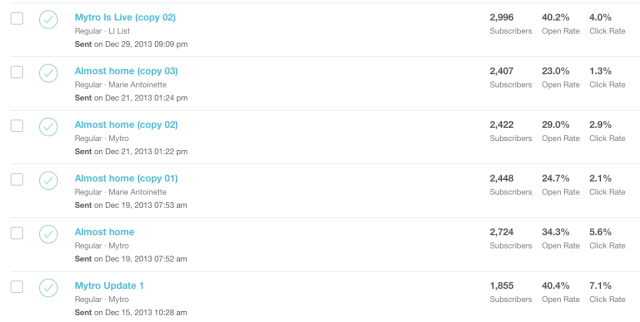As I approach the half-way mark of my crowdfunding project, I wanted to address the thing that makes me feel the worst about this whole process: the spam. As I intimated in in my last post, moving from passive content producer to active content salesperson is hard. As someone used to fire-and-forget posting, convincing others to buy something I’ve built is a hard thing to do. And the best way to do it, sadly, is through spam.

I pride myself on trying to be a nice guy. I post crowdfunding projects on TC all the time because I think they’re cool and I tend to use social media to either make dumb jokes or talk about projects I’ve seen. Now, however, I have to use social media as a sales tool. I contact the vast majority of my Facebook friends directly, have retweeted comments about the book, and even resorted to contacting my LinkedIn and Google+ contacts although I barely use those services. How did I get the most traction, however?
Email.
Take a look at the image above. Aside from a massive Facebook push around Christmas each of those spikes were driven by an email blast sent out on or around that date. Emails took a few days to appear as pledges but after each email I was able to push the total up by at least $1,000. Even given the horrible click rates, those are very compelling numbers.

Now, to be clear, I don’t think it was just the email. These lists consist of people who have signed up for my various projects and folks I’ve met in my travels. They know me and many have the ulterior motive of staying friendly with a TC editor. Would I have the same results of I were some dude selling penis pills online? I sincerely doubt it. However, I could see this working if the email list were in the millions and not in the thousands.
In short, direct contact works best. As one crowdfunder told me “When someone gets an email from you they can do one of two things: ignore it and feel bad/indifferent or act on it.” In my case I was lucky that so many acted on it.
Again, I’ve been consistently amazed how little Twitter and Facebook – aside from direct messages – have contributed to the process. While these tweets and twoots are great for getting the word out – I’m not ungrateful by any means – the actual conversion is limited. Broadcasting “Buy This!” is far less effective than saying “Hey, friend, buy this.”
Do I feel bad about this spam? Well, I’ve tried to keep it to a minimum and now that I’m well past my original $8,000 goal I feel bad for continuing to market. But, in the end, this is a project I love and feel deserves to do well. What would I change in the future? I’d create some sort of system so I don’t re-target backers who have already helped out – that’s something that really upset me and I’ve received two emails from friends about it. Essentially I haven’t found any system for truly segmenting out who I contact although I’m sure solutions exist (and feel free to let me know if you have one).
Still I’m amazed at the reach and power at good old email. It sucks, but it’s true: spam works and it works well. In the end, a nice message, carefully wrought, results in far less blowback than a wonky diet pill email, but the process is the same. Like it or not, direct email is a crowdfunder’s best friend.
This is part of a series on crowdfunding, The Mytro Project. For future posts I’m looking for more input from online analysts and other crowdfunding platforms so please email me at john@beta.techcrunch.com.
